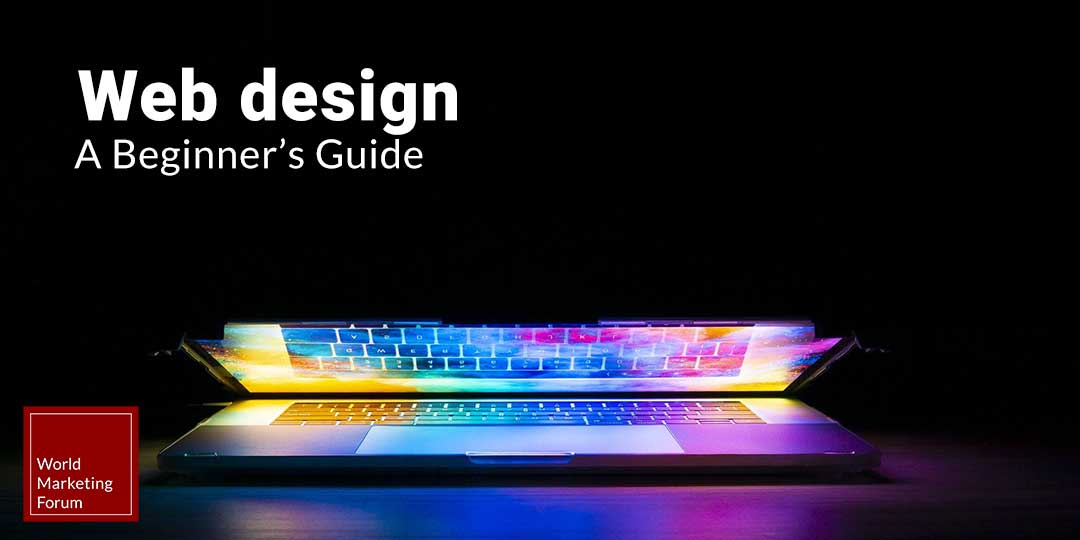Web Design, the First Step for Online Success.
First Impressions are made as fast as 1/10 of a second according to Willis and Todorov First Impressions Study. When a potential customer goes into your website, a strong favourable first impression is of the utmost importance if you want to attract customers and be profitable.
This is where web design comes into the picture. Every time a user visits your website, he will judge it with the first glance, therefore the World Marketing Forum prepared a web design beginner’s guide.
Web design to be efficient needs to match 3 variables, reliability, beauty and functionality.
There are many websites active on the web currently with a number of different designs. But there are a few whose designs captivate their audiences immediately.
Whether you are thinking about hiring a web designer or managing the tasks on your own, having the right knowledge is essential. In this article, we will talk about every relevant point of web design to help businesses make the right decision. From the meaning of web design to building a successful website, this guide covers everything in web design for beginner’s
Table of Content:
- Web Design, The Basics;
- Before you Start.
- Start Building your Website;
- Web Design Tools.
- HTML.
- CSS.
- JavaScript.
- Prototyping.
- Where to Learn Web Design?
- Closing Statement.

Photo by Joshua Woroniecki from Pixabay. Transformed and adapted by World Marketing Forum.
What is Web design?
Webdesign refers to the process of arranging content in a method that gives the best user experience. It is more than how a website looks since it also focuses on how it works.
Web Designer Responsibilities.
A web designer needs to create a perfect balance between many features that sometimes are hard to match. Some necessary skills required for a web designer are good technical skills, interpretational skills, creativity, adaptability to new technologies, up-to-date information regarding recent advancements in code and techniques.
Here’s a list of some responsibilities of a web designer;
- Managing the visual appearance along with coding;
- Developing lean code;
- Making necessary updates in the existing site;
- Correcting technical issues if any;
- Registering the site with different search engines;
- Making the website easy to understand for the visitors;
- …
The 10 “Commandments” of Web Design.
There are some basic rules of web design that you must know to thrive in this area. Here are the top 10 commandments of Webdesign;
Content is King.
A beautiful site design goes hand in hand with useful content. Undoubtedly, a visually appealing website immediately catches the attention, but what makes a user stay? The content available on the site. Always put relevant content on your site that is helpful for your visitors along with a clear call to action.
Make the path easier for them since a lot of thinking from their end for taking the next step might reduce the chances of the steps you want them to take. You cannot expect them to subscribe to your newsletter with your mind-blowing design. If they are unable to find anything useful from your site, they will leave and probably never return.
Make your content as exciting as possible by adding pictures, videos, texts, etc.
Content is King – If your content is valuable, your website users will share it with their peers. Photo by PICHA Stock from Pexels
Build a Mobile-Friendly Website.
You will be shocked to know the number of visitors you can lose by not having a mobile-friendly website. Mobile is the most used mean to access the internet and browse since 2016 in the world. The majority of people make searches using their mobile device (53% in 2019).
Having a site that works great both for desktop and mobile is of the utmost importance. Your potential customers are searching your brand through their mobile devices, and it’s your responsibility to not send them away.
Google ranks your website for its mobile appearance and performance. You can know more about this in our Understanding SEO: How to top rank on Google article
Match your Web Design with the Psychology of Colours.
Colours convey strong messages, and you need to ensure you use them right. According to the type of website, your audience and cultural layout you need to choose the right colour palette.
It’s known that Red & Yellow unconsciously incites hunger and drives a person to feed itself. If you work in the food industry, your brand will more likely be perceived as a good solution to solve their feeding problem. For high education, normally, deep blue or red is used. depending on the subjects covered by the institution.
Website Speed.
Speed is a very important factor top rank on google and also, for conversions. A slow website demotivates consumers to browse and buy your products. Even if they want the product, if the website is slow, they will search for another provider.
For website speed you need two things;
- Good Hosting.
- Lean Code.
Lean & Clean Web Design Code.
Your website design should be as simple and lean as possible, don’t overcrowd your page, and divide the content into visible/separated sections. Also, focus on the font, and use the one that is neat and easily understandable by the users.
Depending on the content that you produce and your target audience, make it easily sharable across social media platforms to increase your reach.
Security Always Pays Off.
When you’re designing your website make sure you follow the most updated documentation and practices for web security. Hackers will constantly try to access your database, inject code and adulterate your PHP code. build a design that will protect you from the majority of cyber attacks, this will save you headaches and will be cheaper than fixing the damages of a corrupted system.
Optimize your website for Search Engines.
It’s essential that your website is found in the search engines such as duckduckgo, google, yahoo, ask, bing, etc. For that to happen you need to fit your website with important SEO tags, build a proper link structure and more.
The World Marketing Forum developed a SEO Guide so that you can create the Perfect environment to Top Rank on Google.
Don’t bend to Advertisers.
Most of the website owners make this mistake of designing their site according to the preference of the advertisers. Your primary focus should always be your users, you can only get advertisement revenue if you have users, so always have this in mind.
Before you Start
1. Have a Vision.
Having a vision and a plan for the desired outcome is essential so that you can be consistent across your web design development.
Bring project management techniques, to help you break-down the project, and remember. Before starting off with the designing process, think about what your potential customer will go through. What content will make them browse more, and reach the final offering? Understanding the steps they will take will make the task easier.
2. Give Special Attention to your Homepage.
This is the page from where the audience will get an idea about the services you offer. Make sure you put in the required efforts in developing an attractive homepage that speaks to your potential customers in the right manner.
3. Have a clear Call-to-Action (CTA).
Your visitors should know what to do next right after landing on your website. Make their tasks easier by giving call-to-action on every page. It will guide users through your website and increase the chances of making conversions.
4. Avoid Using Jargon.
The main aim of your web content is to reach the audience in the right manner. How can you expect to achieve that if the content you post is hard to interpret? Use convincing and straightforward language to compel your visitors to take action.
5. Use Relevant Images.
Images give a huge message to the audience, which is why they play an important role in retaining visitors. According to the content available on your website, use images that speak for them.
Do’s and Dont’s of Web Design.
We created this list to synthesize the information if you want to go through this article faster.
Do’s of Web Design.
- A consistent interface on all your web pages is essential for a professional website
- Focus on easy navigation to avoid the unnecessary hassle of your visitors
- Make sure you give special attention to visual hierarchy for easy scanning by your users
- Go through the website to get rid of available errors
- Use appropriate “buttons” wherever required, and make sure all of them work well.
Dont’s of Web Design.
- No one likes to wait, so avoid a slow-loading website at all costs.
- Avoid using a number of different fonts. Stick to the one that makes your content look neat and understandable
- Automatic pop-ups should appear after a considerable amount of time.
- Don’t use too many ads on the site since it might make your visitors lose interest in exploring the site more.
- Avoid adding background music to catch attention. Most of the professional websites keep it simple and attractive.
Start Building Your Website.
After the fundamental philosophy and mindset take place your foundations are strong enough to start developing your website and apply good web design techniques.
Bellow you will find your Table of Content for this topic.
Start Building Your Website.
Photo by ThisIsEngineering from Pexels
Choose a Domain.
For a business, having a domain is essential since you do not want to approach your client with .wordpress.com, .wix.com or any other right? Buying a domain will cost you money according to the plan you choose. The most important part here to register the domain with the right domain name registrar, i.e. the company that registers domains.
Selecting the right domain name plays an important role as well since this is how your potential customers recognize you. Also, the domain name makes the search much easier. Who will want to type a long IP address every time they plan on searching a site? This also means you need to think thoroughly before choosing a domain name.
Now, the next important part is buying and getting your domain registered. A domain registrar helps us with that task. While choosing a domain registrar, you need to be careful since not every registrar has access to the .com extension, some might focus only on country-specific extensions. Let’s move ahead, and talk about some things to keep in check while purchasing a domain through a registrar.
Choose the Configurations.
You will come across a variety of plans offered by different registrars. The prices will vary according to the plan. The minimum period of registration is a year. Also, you need to see the changes in price on renewal since most of them offer comparatively low price in the first year. While going through the plan, make sure you go through all the extra charges you might need to pay in the future.
Domain Transfer.
While choosing a domain registrar, you must see whether the option of a domain transfer is easily available. This is important because if you are unsatisfied with your current registrar, you should have the option to change easily.
Read the Expiration Policy.
You need to renew your domain name from time to time. In case you forget to do the same, your domain name is available for any other user to pick up. Not the best thing that could happen if you are a business owner. Therefore, make sure you go through the expiration policy before making the purchase.
Compare Registrars.
When you have a number of options, you need to be very cautious while choosing one of them. Shortlist the registrars you prefer, and go through the services offered by each one of them along with the pricing structure. Also, see the add-on services provided by them to make the decision easier.
Photo by Josh Sorenson from Pexels
Choose a Hosting.
Now the next step is to choose a hosting for your website. People are often confused between their own server and a hosting company. Let’s move ahead to understand which one of them is better, and why.
Advantages of Having your Own Server.
There are several advantages to running your own server. When operating your own server, you’re in total control of what’s happening and what will happen when a user goes into your website. Some advantages are;
- Speed will solely depend on you. The configurations you install and parts you use.
- It will give you a boost on local SEO if your target is local and there are no hosting companies with servers near you or if they are inefficient.
- Nobody can shut you down. As you’re the owner of the resources you depend only on yourself.
- You’re in control of the security of your server.
- …
Disadvantages of Having your Own Server.
For large businesses with a consistent revenue generation, private servers might seem to be a lucrative option. But for small business owners, it is good to opt for a reliable hosting company. There are various hosting companies that provide great services to the users.
You can find some Hosting options in our Web Resources list.
Here are a few disadvantages of running your own server;
- The electricity consumed by a home server is comparatively high, and need to be paid timely. On the other hand, hosting companies involve the same in your bill.
- For receiving a high volume of bandwidth (which is essential), you need to pay a huge amount of money. You will be limited in case of hosting at home, which is not the same as a hosting company.
- Although the speed might seem promising but not meet the expectations as much as a hosting company will.
- Even after making the purchase, you need to make a lot of investment in tool replacements.
Native vs. CMS.
This might be another important area of confusion. A Content Management System or CMS can be really helpful for those with less technical knowledge. What can be better than making every relevant change on your website pages without being acquainted with technical skills or hiring an expert for the same?
Here are some of the main reasons why you should opt for a CMS;
Convenience.
Firstly, using a CMS saves a lot of time since the tasks become much easier. In case of a design that requires custom coding, you surely do not want to miss having a CMS. All the hectic and time-consuming tasks are performed quickly. Also, a CMS suggests valuable updates that can be done to improve the performance of the site.
Work Load.
As discussed earlier, content should go hand-in-hand with the appearance. Working with a CMS makes the tasks more manageable for both the writers and web designers. The communication level improves, and a proper flow is maintained.
Photo by Markus Winkler from Pexels
Community Support.
Choosing a CMS has advantages in terms of the support you might get from the community. WordPress powers >38% of world websites, it’s millions and millions of people using and administrating WordPress. This means that if you have a problem with your website you can easily find documentation and professional help to solve it. Alongside it, you have a library of thousands of plugins to increase your website possibilities, fastly and efficiently.
Web Design Tools.
HTML, CSS, and JavaScript are the holy trinity of Website development. HTML manages the content of the website, while CSS focuses on the presentation part, and JavaScript manages the behaviour of the webpage. These three technologies are more than enough to make a fully functional dynamic website with animations and effects.
HTML and CSS are for the front-end development for the user side while JavaScript is both front-end and back-end, meaning it can be used on both the client-side as well as on the server-side. If you are in a hurry and want to make a website but have no time to learn, then you can use content management systems like WordPress, which provides pre-designed templates and drag and drop features to develop a website without knowing a line of code quickly.
Photo by Tima Miroshnichenko from Pexels
HTML.
HTML stands for Hyper Text Markup Language, and it is the markup language used by the browsers to display the contents of the web page. HTML uses different sets of tags to format the material to be displayed on the webpages. It is the most fundamental building block of the web, which, when combines with CSS and JavaScript, gives you the perfect design for your website. If someone wants to learn how to create a good-looking website, then HTML is the starting point.
HTML on its own is nothing more than just a way to present your data on a webpage simply. The most you can do with HTML is make a simple-looking webpage with some headings, paragraphs, images, tables, and forms. You can also provide basic formatting, like resizing the test or changing its color. But to take things up a notch, you have to use CSS, which focuses on the appearance and presentation of your HTML contents.
The H in HTML stands for “Hypertext” which refers to the link which connects different web pages either from the same website or different. Just provide the correct link, and that it. The worldwide web is a network of these inter-connected webpages and websites.
A webpage consists of HTML code, which is decrypted by the browser, and the required result is displayed on the screen. You can write code for an HTML document in a simple text file and save it with an extension of .html. So how does an HTML document looks like?
To understand an HTML document first, we have to learn about something known as tags. Anything inside an HTML document is enclosed in a tag. To differentiate between regular text and tag angle brackets are used. Anything surrounded by the angle brackets is a tag, for example, <br>, which is used for a line break. This tag is a self-closing tag which means it does not needs to be closed, but there are different type of tags which need to be closed like a body tag for example: <body> “Your content” </body>. A tag is closed by using a forward slash, followed by the tag name. With tags out of the way, let’s see what the elements which make up an HTML document are.
An HTML document starts with <html> tag which holds the <head> tag and the <body> tag.
The head is where we declare the title of the page, and it also contains the meta-data related to your web page. You can also provide links to the CSS and bootstrap files in the head tag.
The body tag defines the document’s body. It is where all the content of your HTML document goes like text, images, tables, hyperlinks, etc. Some tags are provided with different attributes to style the content and set their appearance. But the best way to style your HTML is to use CSS.
CSS.
Cascading Style Sheets, also known as CSS, is a style sheet language used to describe the appearance and presentation of an HTML document. CSS manages how HTML documents are to be displayed on different devices. Using CSS can save a web developer a lot of time as CSS can manage the designing and styling of multiple webpages at once. CSS can be used in HTML in three different ways which are: Inline CSS, Embedded CSS, and External CSS.
Inline CSS
Inline CSS is used inside a single tag to give it the required style. Only one HTML element uses this type of styling, and the rest of them are unaffected or remain the same. This type of CSS increases the workload and time as we have to define CSS code for all the elements separately, which is not the right approach.
Embedded CSS
Using Embedded CSS, instead of writing CSS for each element, what we can do is use embedded CSS, which is defined in the head tag using the <style> element. Styles provided in this tag for a given element will be applied to all the elements in the HTML document. This approach if fast and efficient and therefore preferred over Inline CSS.
External CSS
External CSS is considered a good practice to separate your HTML code from your CSS code as keeping both of them in the same file will increase the number of lines of code to manage and will decrease the readability of your code. One more advantage is that with external CSS, you could use the same CSS file in different HTML documents. You can write your CSS code in a separate file and then use the <link> tag inside the <head> tag of your HTML file and provide the path to link the CSS file and voila. Now you have a separate CSS file linked to whatever HTML document you want. An external CSS file is a text file ending with a .css extension.
Rules when using CSS.
There are certain sets of rules that need to be followed while writing CSS. To provide style to a specific HTML element using CSS, CSS requires two things you can also refer to this as a general syntax: a selector and a declaration block. A selector refers to the HTML element that you want to style. A declaration block is surrounded by curly braces and consists of one or more declaration separated by a semicolon. A declaration is a pair of property its value. A property could be something like color, and value can be blue.
CSS has three types of selectors, which are the element selector, the ID selector, and the Class selector. An element selector referees to an element of HTML and applies the style to all the elements of that name in the document. Next is an ID selector in which you can provide a unique ID inside an HTML tag and later refers to that ID in CSS file to apply the style. An ID is unique, and no two tags can have the same ID value. The class selector works the same as an ID selector, and the only difference is that multiple tags can use the same class name.
JavaScript.
JavaScript, also known as JS is a client-side scripting language that runs inside a web browser to provide dynamic webpages and special effects to it. JavaScript has multiple frameworks and multiple applications, but it is mainly used in building websites and web applications. Currently, JavaScript is the world’s most popular programming language because of its wide range of applications, and it is easy to use. If you are already familiar with the programming languages like C++ or Java, it would be a piece of cake for you to learn JavaScript.
Even if you are not familiar with any other programming language and are just a beginner, still it will take you no time to learn Java Script.
Conclusion, JavaScript is the hottest language in the market and has multiple benefits in learning it.
JavaScript is a crucial part of a web page, along with HTML and CSS. It makes the webpages interactive and provides functionalities like scrolling animations, and provides with a vast range of effect which can make a website stand out.
As stated earlier, JavaScript has multiple frameworks for both front-end and back-end development. AngularJS created by google and jQuery are two of the most popular front-end frameworks used in creating Interactive Web Applications.
Photo by Canva Studio from Pexels
Before JavaScript became popular, hosting a website on the Internet means you need to know a server-side language like PHP so that you could deploy your website on the server. But now you can run the JavaScript code in both the browser and on the server using frameworks like Node.js, which helps execute JavaScript code on the server. Which means no need to learn different languages to be able to connect front-end and back-end and deploy your website on the Internet, JavaScript got you covered.
JavaScript code can be used in an HTML document by enclosing the code inside the <script> tag. The script tag can be used anywhere in the HTML document, in the head, or inside the body of HTML or even outside of the body, depending on when you want the script to execute.
Although it can be used anywhere in the document, it is best to write it after the body tag so the first the HTML and CSS can be loaded into the browser, and then the JavaScript code is executed. This makes your webpage load faster, and the user does not have to wait for a few seconds for the page to load with all those animations and effects.
To be able to use JavaScript code across multiple pages, the script can be written in separate files ending with the.js extension and linked to HTML just like CSS. To use external JavaScript files inside an HTML document, use the src property inside the script tag, and provide the file path.
Photo by picjumbo.com from Pexels
Prototyping.
The term prototyping in web designing means creating a demo of a website before going knee-deep into developing the real website. The demo can be used to get feedback and improvements ideas from the user/client.
When working on big projects, it is always better to first fully understand the user or your client’s requirements before going forward with the development part because there is still room for improvements and upgradations during the early stages of development. But, once you have completed the whole designing aspect and your client rejects your idea or design, then there is nothing else to do but to start from scratch.
A prototype can be a hand-drawn rough sketch of the final product, or just a simple HTML clickable skeleton, a PowerPoint presentation, or a pdf sample. The format does not matter as long as you are clear in expressing your ideas through it. There are multiple tools out there to help you create an up to the mark looking prototype of your project.
It is up to you which software you use according to your knowledge and experience. Tools like InVision and Adobe Experience Design are two of the widely used UI/UX designing prototyping software. Both are cross-platform applications, free to use, and you can learn then in no time.
The advantages of Prototyping are: you can get the approval of your on the design client before coding a single line of code. You can work on any updations/suggestions on the layout and structure of the website, and most importantly, gather feedback.
Where to Learn Web Design?
The best place to learn Web Development is a website know as w3schools.com.It is well documented and well organized, and it is the most popular website when it comes to learning web development. No matter if you are a beginner or an expert, this site has a little bit to offer to all.
Many websites offer paid and free web development courses on the Internet, and they also provided the certificate at the end of the course. A few of the popular websites are coursera.org, udemy.com, and edx.org.
Closing Statement.
These were some of the main areas related to web design that you need to focus on. Before investing any money in any particular area, make sure you read and analyze properly. Also, spending money on your website’s design to make it unique and attractive is worth it.
Your potential customers will find their way to you through your website, make sure you make it as easy as possible for them. Go through the points as mentioned earlier as many times as you prefer and make the right choices.






